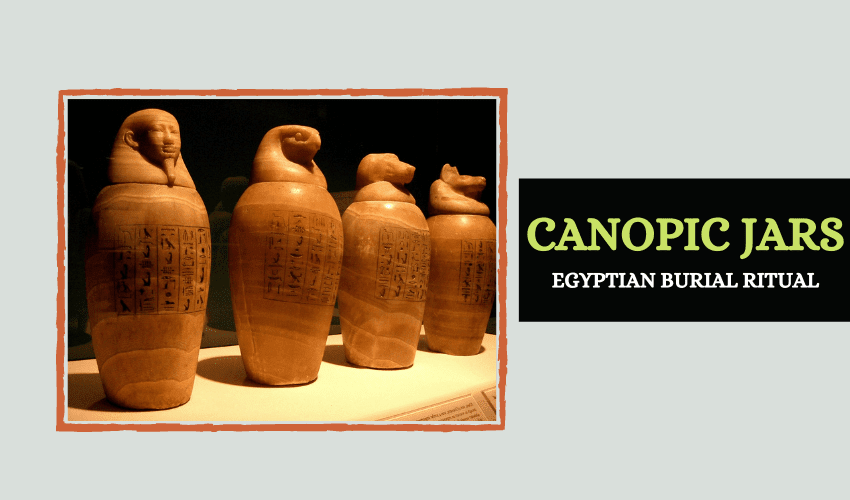
Table of Contents
Mortuary rituals were a fundamental part of ancient Egyptian culture and consisted of several steps in a long process. Within the mummification process, the use of Canopic Jars was a crucial step. These jars were instrumental in the journey of the deceased, through the Underworld as they would ensure that the person would be complete when they entered the afterlife.
What Were Canopic Jars?
Canopic jars first appeared in the Old Kingdom and varied throughout history. However, the number never varied – there were always four jars in total.

The jars were the recipients within which Egyptians placed the vital organs of the deceased. This practice was part of the mummification process and the mortuary rituals. The Egyptians believed that some viscera (i.e. the internal organs of the body) had to be kept in these jars since it was necessary for the afterlife.
The Canopic Jars were typically made out of clay. Later on, the jars were made with more sophisticated materials, including alabaster, porcelain and aragonite. The jars had removable lids. These would evolve to feature the shape of protective gods, known as the Four Sons of Horus, the god of the sky.
Below is a list of the editor’s top picks featuring Canopic Jars.
The Purpose of the Canopic Jars
According to some accounts, ancient Egypt was the first civilization to believe in some kind of afterlife. The heart was the seat of the soul, so the Egyptians ensured that it remained inside the body. However, the Egyptians believed that the intestines, liver, lungs, and the stomach were necessary organs for the dead in the afterlife. For this reason, these organs had a special place in the mummification process. Each of these four organs was placed in its own Canopic Jar.
Although the classic function of the Canopic Jars was to preserve these organs, excavations have shown that the Egyptians did not use the Canopic Jars as a container in the Old Kingdom. Many Canopic Jars that were excavated were damaged and empty and appear much too small to hold organs. The evidence suggests that these jars were used as symbolic items, rather than as practical objects, during the early mortuary rituals.
The Development of the Canopic Jars
In the Old Kingdom, the practice of mummification was in its early stages. In that sense, the Canopic Jars used during that time had nothing to do with the ones to come. They were simple jars with conventional lids.

In the middle Kingdom, as the mummification process evolved, the Canopic Jars also changed. The lids of this period had decorations such as sculpted human heads. In some cases, these decorations were not human heads, but the head of Anubis, the god of death and mummification.

Period: Third Intermediate Period, public domain
From the 19th dynasty onward, the Canopic Jars had associations with the Four Sons of the god Horus. Each one of them represented a jar and protected the organs inside it. Apart from these gods, each organ and its corresponding Canopic Jar also had the protection of a specific goddess.
As embalming techniques evolved, the Egyptians began to keep the organs inside the bodies. By the time of the New Kingdom, the purpose of the jars was again merely symbolical. They still had the same four gods sculpted on their lids, but their inside cavities were too small to keep organs. These were simply Dummy Jars.
The Canopic Jars and the Sons of Horus
Each one of the four sons of Horus was in charge of protecting an organ and had his image sculpted on the corresponding Canopic Jar. Each god was in turn protected by a goddess, who acted as a companion of the corresponding god-organ-jar.
- Hapi was the baboon god who represented the North. He was the protector of the lungs and was accompanied by the goddess Nephthys.
- Duamutef was the jackal god who represented the East. He was the protector of the stomach and his protectress was the goddess Neith.
- Imsety was the human god who represented the South. He was the protector of the liver, and was accompanied by the goddess Isis.
- Qebehsenuef was the falcon god who represented the West. He was the protector of the intestines and was protected by the goddess Serket.
These deities were a distinctive mark of the Canopic Jar from the Middle Kingdom onwards.
Symbolism of the Canopic Jars
The Canopic Jars attested to the importance of the afterlife to the Egyptians. They represented protection, completion, and continuation for the deceased as they crossed over to the afterlife. The Egyptians associated the Canopic Jars with a proper burial and mummification.
Given the importance of mummification in ancient Egypt, the Canopic Jars were a significant item and symbol. Its associations with different gods gave the jars a central role in the mortuary rituals. In this sense, these items were priceless for the Egyptians. They offered protection to the organs and ensured the life of the deceased in the afterlife.
Wrapping Up

The Canopic Jars were significant for the Egyptian culture since they were firm believers of the afterlife. The process of taking the organs out and securing them for eternal life was one of the most substantial steps of the mummification process. In this sense, these jars had a role like few other items had in Ancient Egypt. The Canopic Jars appeared in the early stages of this culture and remained notable throughout its history.











